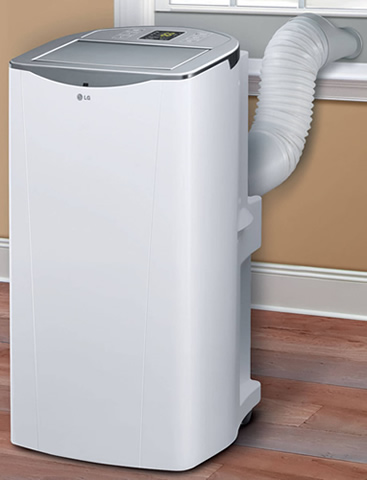Portable Air Conditioners
As a cheaper and more convenient alternative to central HVAC systems, portable air conditioners provide cool air during summer wherever you need it, whenever you need it!
There are several advantages as well as disadvantages to this kind of cooling solution, which we'll take a look at in this section of our website.
First of all, it would be helpful to know the major differences between central cooling systems and their portable counterparts.
Comparing Central to Portable Coolers
Central systems are generally building-wide distributed cooling and/or heating setups where the warm or cool air generation is produced by a central unit and distributed throughout the building via ducting to outlets situated in each room.
The hot, moist air that these systems produce as a by-product of the refrigeration process when cooling needs to be vented to the outside.
This is generally achieved by connecting to an outside extraction unit that is installed on a roof or other convenient place outside.
Portable cooling and/or heating units are standalone appliances that can be moved easily to the room or area in a building where they are needed to provide heat or coolness. The units are typically set on caster-type wheels for free movement and simply plug into a convenient electric wall-socket to be operated but require an outlet to connect a flexible exhaust hose to which makes it possible to expel the hot, moist air that is produced to the outside of the building.
Advantages of Portable AC Units
The advantages that portable air conditioners have over central systems lie mainly in their portability and small size. In addition to that, they have a distinct versatility in the ability to deploy a single unit in the place that cool air is most needed.
Here's what I mean.
With a central system, it needs to produce a lot of cold air in order to cool the entire building, even if only one room happens to be occupied at any given time. That can add up to a lot of wasted energy, not to mention a hefty energy bill at the end of the month!
In situations where there may be only one person in the house or office, they can only be in one room at any time, so it makes sense to concentrate the cooling energy in that one space. That's not always possible or economical with a central system, but with a single portable unit, it is very easy to simply wheel the unit into the room where the person intends to be, turn it on and enjoy cool air only in that space and not waste it in unoccupied rooms.
Disadvantages of Portable AC Units
There are some disadvantages that the potential buyer needs to be aware of before they go and buy one of these versatile coolers. Let's take a look.
The first big downside is that all portable air conditioners must be vented to the outside. This is usually achieved by connecting the flexible plastic vent hose to the back of the unit at one end at to a convenient outlet at the other.
That outlet can be a purpose-built vent made in an exterior wall. In most cases, however, the outlet ends up being through an open window, which has its own array of disadvantages:
- Cannot close the window properly, so some hot air gets in
- Security is compromised if the window cannot be locked
- The setup looks ugly
Most portable AC units come with a window fixing kit that allows the hose to be fixed to the window opening while blocking off the rest of the gap. This prevents the ingress of hot air from outside, but does not remedy the security issue.
Another problem is that by needing to fix an exhaust hose to an outlet, the portability aspect is diminished. That's because once the unit is in place, it is not so simple to move it to another location. The vent hose needs to be retracted from the window or outlet and placed in another outlet once it has been moved to its new position.
There is not always a conveniently placed window, much less a fixed through-the-wall outlet in the place you want to put the cooling unit.
There is More to Learn
So there you have the pros and cons of portable air conditioning units in a midi-sized nutshell. But there is far more to be learned and understood on this subject.
So I'll add more information about this side of climate cooling and heating in additional articles.
[Back to TOP]